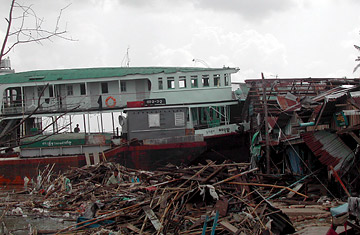
A passenger ferry is washed ashore in Laputta, Irawaddy Delta region on May 8, 2008, following Cyclone Nargis.
Aung Than Htay's injuries seem slight until he tells you how he got them. The arms of the 30-year-old fisherman are grazed from wrists to armpits. A week before, he had clung to the trunk of a palm tree as a 12-foot storm surge carried off his wife, his infant son, and his four-year-old daughter. "My wife tried to hold on to my waist, but the water dragged her away," he says. He clung to the tree for three hours. When he finally descended, the water in his village of Ka Ka Yon still came up to his chest. He found the body of his seven-year-old daughter at the foot of the tree. He never found the rest of his family.
Aung Than Htay is walking along the road to Laputta, a cylone-shattered delta town teeming with tens of thousands of refugees. Before Cyclone Nargis hit, the population of this sleepy riverside town was 30,000. With the hungry, homeless and bereaved pouring in from the delta — 80,000 have perished in this district alone, according to local aid workers — that refugee population has now reached six figures.
"I've had long experience of emergencies and I've never seen anything like this," says Julio Sosa Calo, head of mission in Laputta for the German relief group Malteser International. "We need a huge humanitarian response. What we're doing now is too little compared to the need." There are now 58 camps in town, most of them set up in temples, monasteries and schools. More survivors arrive every day. "To be honest, we're all a bit lost when it comes to numbers," confesses Sosa Calo. "People know that this is the place where they can get assistance, so they're coming in huge numbers."
Laputta should be the center for a gargantuan relief effort. Should be, but isn't. Trucks carrying food and water ply the rough road leading to this isolated town, but not in the large convoys associated with a disaster of this scale. Laputta's buildings are collapsed or roofless, its streets clogged with fallen trees, smashed boats, and the rain-soaked debris of thousands of desperate families. Local aid workers estimate that 12,000 people have died and 3,000 are missing in Laputta town and its immediate surroundings.
There are tens of thousands more in need in even more remote parts of the district, but the few foreign agencies in town are struggling to help them. "We don't have the means," says Sosa Calo. "To reach affected areas we have to use the river. And most of the boats in the area were destroyed by the cyclone." One area in Laputta district called Pyin Sa Lu was hit badly by the 2004 Indian Ocean tsunami, which destroyed houses and almost certainly lives (the junta released no data), then struck again by Cyclone Nargis. This time, more than 10,000 people died.
The military has forbidden expatriate aid workers from entering such areas. Local fishermen have been instructed not to take foreigners on their boats. According to one aid agency, soldiers have told villagers that any foreigner seen in this forbidden zone during the day will be turned around, and if seen during the night, they will be shot. "Basic needs are not being met, particularly in remote areas, which are difficult to access without boats," says a Western aid worker who asked not to be named. But these logistical problems could be overcome "without much difficulty if it weren't for the [junta's] restrictions."
Many survivors in the outlying regions are sticking close to the ruins of their homes in case missing family members show up. But more than 10 days after the cyclone hit, that is unlikely. "Missing means dead," says a Burmese health expert returning from Laputta. "They're not coming back."
Other survivors are staying put in an attempt to recultivate their land. Rice scheduled to be planted in the coming weeks has to be harvested in October, by far the biggest of the twice-yearly crops. But the farmers face appalling odds. Their fields are inundated with sea water and there are no pumps to drain them; the buffalo that pull their wooden plows are drowned. Laputta resident Myint Shwe tells how the cyclone claimed 20 of his cows and buffalo, wrecked his house, and destroyed his boat. He can now only plow his land "if the government gives us equipment," he says. "No equipment, no rice." He is unlikely to get it. He and his large family have yet to receive aid of any kind.
